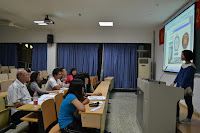The evenings here are alive with people. Around the college, even at 9pm at night there are students in classes or study groups, others playing music and rollerblading or just chatting around the campus – I even saw a skateboarder. Couples head towards the river for some privacy and to walk together.
I haven’t been out much at night, usually just around the campus district. I’m generally pretty tired at the end of the day, and always get up around 5:30 for tai chi. The last couple of nights though, I’ve started walking a bit further afield.
I don’t know much about the rest of China, but here in Quzhou, both sides of the river are pubic spaces with landscaped gardens, civic sculptures with spaces for people to enjoy the surroundings. In the evenings they are filled with people out socialising. I’ve already mentioned the large dancing group in another post. This is only part of the story.
In the evenings the spaces that are used for tai chi and exercises in the mornings are used for other activities. This mainly involves dancing, and usually only women. There appears to be different ‘schools’ who have slightly different dancing routines, but there are others that are markedly different, for example one I saw tonight was a group of younger women doing fairly aerobic routines that look like they came from video clips. Who needs gyms when you have this?
On the other side of the river there is an area where there were people singing what sounded to be traditional songs with live accompaniment. Because everyone likes things loud here, the voice and music were amplified, if a little distorted.
Interspersed between groups there are pairs or individuals doing all sorts of exercises – mainly men, but also some women. The range and diversity is incredible, many seem to have there own personal favourites not shared by anyone else. probably the most common (after walking backwards, arms in the air, clapping front and back as you walk) is chi gung. These are static tai chi type exercises that increase the flow of chi.
I watched one man repeat the same movement for over 5 minutes. On another occasion I saw men practicing ‘push hands‘, a technique where two people circle their arms and try to get to opponent off balance.
It’s difficult to describe the feeling of just being able to walk around the city in the evening and be surrounded by people out and about just enjoying themselves in these social activities.
This short video is of the group playing and singing traditional songs.
I haven’t been out much at night, usually just around the campus district. I’m generally pretty tired at the end of the day, and always get up around 5:30 for tai chi. The last couple of nights though, I’ve started walking a bit further afield.
 |
| Dancing by the riverside |
In the evenings the spaces that are used for tai chi and exercises in the mornings are used for other activities. This mainly involves dancing, and usually only women. There appears to be different ‘schools’ who have slightly different dancing routines, but there are others that are markedly different, for example one I saw tonight was a group of younger women doing fairly aerobic routines that look like they came from video clips. Who needs gyms when you have this?
 |
| One group playing and singing in the foreground and another group in the background |
Interspersed between groups there are pairs or individuals doing all sorts of exercises – mainly men, but also some women. The range and diversity is incredible, many seem to have there own personal favourites not shared by anyone else. probably the most common (after walking backwards, arms in the air, clapping front and back as you walk) is chi gung. These are static tai chi type exercises that increase the flow of chi.
I watched one man repeat the same movement for over 5 minutes. On another occasion I saw men practicing ‘push hands‘, a technique where two people circle their arms and try to get to opponent off balance.
It’s difficult to describe the feeling of just being able to walk around the city in the evening and be surrounded by people out and about just enjoying themselves in these social activities.
This short video is of the group playing and singing traditional songs.





















































